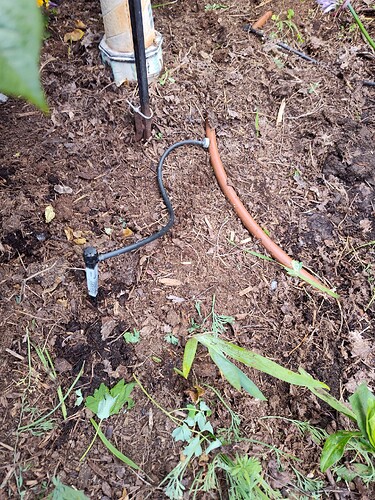![]() that just sounds like more trouble than it’s worth. I’d lay something like that on top of the soil not underneath it.
that just sounds like more trouble than it’s worth. I’d lay something like that on top of the soil not underneath it.
Yes. You could start that way. But after years of mulching, the pipes will be underground. In sum, drip systems require a lot of work. Overhead systems spot the blooms. Looks like watering by hand is not that bad an option.
I understand this not a scalable solution, but for my roses in Texas I had a bubbler on each rose. The bubbler was about 3 inches above the soil. Not high enough to hit the leaves but also low enough to water in any fertilizer. Each bubbler could be controlled for the amount of water delivered at that spot. It does require extra irrigation work, but was a good solution for a ~35 rose garden on an automatic timer.
I live in the desert in the Las Vegas area. Before I lived in So. California. Both places are hot and dry in the summer. Las Vegas can freeze in the winter.
I have been using an automated drip system with1/4” “spaghetti” lines around each plant. I also have EZ-flow automated feeding system I just had installed a few months ago. It made a huge difference in the quality and size of leaves and petals. I have 40 roses, 22 sagos, 12 bougainvilleas and 5 citrus trees as well as olive and bottle trees.
I have around 300 roses i water three zones with a 4 outlet timer
Water time is 30 minutes per zone rvery day late afternoon
Using a b rown drip hose with a valve rveru foot yhat drips .9 gallons an hour.The hose comes in a 250 ft roll and lasts forever
Iake a tre ch 6 imched or more and lay the hose in and pon it with giant staples
Bury the hose and then mulch
Stuff is available at
Irrigztion centers.the whole sydtem runs on 2 AA batteries for the summer. If it rains i shut the timer off.
Hi, I use a drip system. The person that originally installed it knew nothing about roses. He put is a small ring around the base. This is now way too small, so I am changing it over to small drip emitters. So much easier to maintain.
Leslie,
What do you do with the emitters when you mulch, apply fertilizers, pesticide granules, compost, and so on? Do you take them inside over the winter?
Frank
Frank, I leave my system in the ground. The emitters are about four inches above ground.
I have not mulched yet. Usually 3". I carefully put the entire above the mulch. I turn off the system around October, before winter. Zone 8B
That should say emitter above the mulch
I agree the Witherspoon Hose Emittors are great but I do not believe they sell them any longer. If you find where they can currently be bought let me know.
Hi I have tried a lot of systems over 40 years. Previously I gave up on drip systems with spaghetti tubing - WAY too fussy with tubes getting pulled out all the time. Using a hoe with spaghetti tubing is a pain. I went back to overhead but using 0 degree 4’ radius nozzles, with a 6" pop up. That works OK, but does waste water. It does wash off spider mites nicely, though. I really want to go back to a drip system, but want something robust I can mulch / weed over. I have wondered about dripline but the spacing minimum for 1/2 tubing is 12 inches - maybe too far apart? I have also wondered about using a drip ring for each plant. Or just using multiple lines of drip tape, but that is designed for flat beds with linear rows of plants. Anyone figure out a more robust drip system for roses than using spaghetti tubing? Thanks! John
I should add I am talking about a fairly large garden, with about 500 roses in 1 acre.
Don’t use the drip rings around the roses. They clog quickly, and as the rose grows, the rings stretch, and disconnect. I took off all my rings, and put drippers below each rose. They soray like a tiny umbrella
John, the 1/2" drip system using 12" emitters is still probably the best, just manifold several lines up to a header and then stagger the long lines so you have emitters every 12" on one line and then next to it you have an emitter starting out at 6" and then every 12". Alternate as you need to get a diamond pattern of 6". The tubing is still simple straight lines easy to weed around. No loose ¼” side tubing. Also easy to un-cap the far end of the 1/2" lines to flush out once a year. You can add various valves to control zones as needed.
Thank you for that - makes sense. I will give that a try for next year. Something to do over the winter… ![]()
It has been a bit over 2 months since I posted the topic. Since then, for reasons concerning mulching, fertilizing, hoeing, aerating, and replanting, I have come to favor a simple drip system as Mark has described. My roses are planted in rows. The tubing is about 8 inches from the base of each rose on both sides. I think it important to keep the tubes near the surface. Do not pile mulch on top every year without lifting the tubes back into a near-surface level. Otherwise, over time the tubes will get buried and clogged. A lesson learned from experience.
